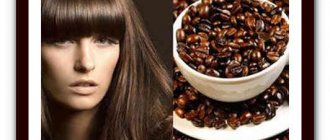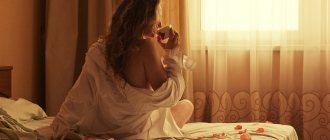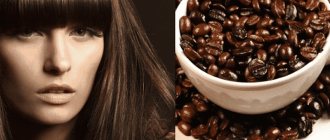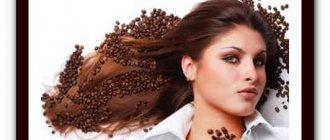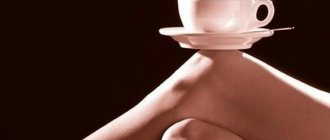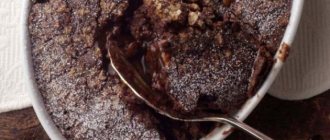Pros and cons of dyeing hair with coffee at home
Coffee does not harm your hair
. Coloring with coffee-based products has both advantages and disadvantages. The advantages are as follows:
- Unobtrusively and naturally refreshes hair color.
- Strengthens and nourishes curls, giving them softness and silkiness.
- Promotes increased growth of each hair, strengthening follicles, preventing their loss.
- Coffee has a pleasant smell, which, of course, will last for a certain time and will delight you during the first days after dyeing.
- It does not harm the hair, unlike dyeing it; on the contrary, it heals it.
- Allergic reactions to this type of painting are extremely rare.
Disadvantages of dyeing with coffee:
- Doesn't cover gray hair well.
- It has a very natural and invisible result, so in order to significantly change the color, you will need to spend a lot of time repeating the coloring many times.
- Those with blond hair may get an uneven effect; coffee dye may leave unsightly spots.
- Hair dyed using this technique may leave marks on clothes, pillows, etc.
Some recipes cover the indicated disadvantages. Choose the one that suits you best.
Benefits and harms
Before discussing recipes for coffee hair coloring, let's consider the advantages and disadvantages of this cosmetic procedure. Let's talk about the good stuff first.
Benefits of coffee:
- is a natural product and will not cause any harm to the hair;
- allows you to qualitatively change the structure of the hair, making it thicker, which will give the hair additional volume;
- saturates hair with natural shine;
- slightly dries oily hair, which will allow you to avoid the procedure of daily hair washing;
- makes strands more manageable and easy to style;
- activates the growth of strands;
- fights baldness;
- gives hair a wide range of shades.
Notable disadvantages of coffee coloring are:
- inability to properly cover gray hair;
- difficulty in selecting the required shade;
- significant duration of the procedure;
- instability of the resulting color.
Centuries of experience in using coffee in hair coloring have led to some conclusions that need to be taken into account:
The main thing is that you can only use natural coffee, but not instant coffee.
To speed up the hair dyeing process, you should choose the finest raw materials.
You should not use coffee when tinting light hair, because the shade may turn out to be very unexpected or very uneven. Coffee dyeing is ideal for brown-haired women; this method will help them shade and saturate the color.
The shade obtained in this way can decorate the hair for about a week, then the coloring will have to be done again. You can increase color durability with henna.
In order to get rid of the stickiness that appears on the hair, it is wise to use conditioner. It perfectly eliminates this unpleasant drawback.
To obtain the color of the required intensity, it may be necessary to re-stain.
To select the exposure time, conduct an experiment on one strand.
When using natural dyes, it is not recommended to use shampoos that contain sodium lauryl sulfate; this substance helps slow down hair growth and washes out the resulting color.
Classic way
Giving hair silkiness and shine.
Suitable for strengthening hair, giving it silkiness and a light coffee tint. This coloring can withstand three or four washes, after which it is necessary to update the color again.
As in the case of subsequent dyeing methods, immediately before the procedure itself it is worth conducting a test for an allergic reaction to the components of the mixture: apply the finished composition to an area of the skin (for example, the wrist), if there is no irritation, itching or other unpleasant sensations, then you can proceed to coloring.
Preparation of the composition:
- Brew two hundred milliliters of very strong coffee, about fifty grams of beans per glass of boiling water, add a little balm or hair oil if desired.
- After cooling, apply evenly to the strands and wrap with film.
- Wash off after half an hour.
Positive properties of coffee
The coffee drink is famous for its polyphenol content, which strengthens hair, as well as carotenoids, chlorogenic acids, which add shine and protect hair.
That is why coloring in this way is safe since it consists of natural ingredients. It also has a positive effect on your hair. Coffee also helps reduce the appearance of dandruff.
Making a spray paint
Suitable for those who are too busy
This method follows from the previous one, but is convenient and time-saving. It is perfect for girls who do not have enough free time for full coloring, but want to give their hair a light coffee shade and make it healthier.
Preparation:
- Prepare the mixture according to the previous recipe.
- Test for an allergic reaction.
- Pour into a spray bottle and use the spray after each shampoo.
Coloring with coffee and henna
A reddish tint is created.
This recipe will appeal to girls who want to strengthen their hair and give it a chocolate or chestnut tint, depending on the henna (colorless or colored, respectively). This coloring lasts a little longer than the classic one, again, depending on the properties of the henna used.
Preparation of the composition:
- Dilute twenty-five grams of henna with fifty milliliters of warm water.
- Pour fifty milliliters of coffee grounds into the resulting solution and mix the mixture thoroughly.
- Check whether “coffee dye” does not cause allergic reactions.
- Apply to curls.
- After forty minutes, rinse with water.
Coloring recipe using coffee and cognac
You will get a brown color with a beautiful shine.
This product dyes it a beautiful brown color, giving your curls a healthy shine. Preparation of the composition:
- Mix two tablespoons of cognac, two teaspoons of ground coffee beans and two chicken egg yolks. If desired, add a little hair oil and water. You should get a homogeneous consistency.
- Check the mixture for hypoallergenicity.
- Leave it for half an hour in a dark place and let it brew.
- Distribute through hair and leave for at least thirty minutes.
Conclusions:
- Coffee is great for coloring hair, darkening it by 1-2 tones. On light brown hair it looks more chocolatey, on dark hair it gives deep shades of brown, on red hair it looks darker copper.
- Blondes and gray hair should use coffee as a dye carefully; there may be risks of uneven color.
- The natural dye does not harm the hair, and even vice versa: it restores and strengthens it, stimulates growth, makes it stronger and more elastic, and fights split ends. You can either rinse your washed hair with the infusion, or apply masks with balms, conditioners, and oils to dirty, dry hair.
- If something goes wrong, the shade will wash off in about a week.
If you liked the site, share the link with your friends. Thank you!
Coloring mask with coffee and rum
A rum-coffee mask is needed to give a golden-brown hue to light-brown hair.
After using this coloring mask, light-brown hair becomes stronger and acquires a golden-brown hue. Preparation of the composition:
- Combine two chicken egg yolks and thirty grams of cane sugar into a homogeneous consistency.
- In a separate container, mix one hundred grams of ground coffee with fifty milliliters of rum.
- Combine both mixtures into a homogeneous consistency.
- Make sure there is no allergic reaction.
- Apply the resulting compound to your hair, distributing it evenly, and wrap your hair with film.
- Wash off after forty minutes.
Coloring with coffee and cinnamon
The result will be a rich chocolate or golden brown color.
Depending on the hair undertone (warm or cool), the coloring result varies from golden brown to rich chocolate shades, respectively. Preparation of the composition:
- Pour into the mixture fifty milliliters of cognac and two chicken yolks, a mixture of ten grams of powdered cinnamon and one hundred grams of ground coffee. Mix the mixture thoroughly.
- Check it for hypoallergenicity.
- Apply to hair and leave for an hour, then rinse.
Recommendations for use
It would seem that coloring with natural coffee could not be simpler. But listen to some recommendations for use.
1You should not use this dyeing method on previously chemically dyed or curled hair. The shade may turn out unpredictable.
2To achieve a lasting and brighter shade, do several procedures, with subsequent use the color will become brighter.
3To prepare the dye, give preference to natural ground coffee.
4To achieve the maximum effect after applying coffee to your hair, you should put a plastic cap on your head and wrap it in a towel.
5Apply the mixture only to dry hair.
6When preparing the mixture, make it homogeneous and not thick so that it can be easily applied to the hair.
Coloring with a combination of coffee and natural dye (using the example of basma)
Basma is absolutely not suitable for blondes.
This type of dyeing will give the hair a darker coffee shade, making it shiny. Just like the method with henna, it is durable. Preparation of the composition:
- Pour fifty grams of ground coffee beans into a glass of boiling water.
- Half an hour after brewing, add fifty grams of basma (or to obtain a warmer shade, mix twenty-five grams of henna and basma), a tablespoon of honey and bring the mixture to a homogeneous consistency, stirring.
- Make sure there are no allergic reactions to the coloring mixture.
- Distribute the mixture over your hair and wrap it with film.
- Leave for half an hour, then rinse.
Recipes for coloring compositions
There are several ways to dye your hair with coffee at home. The result is approximately the same, but in addition to acquiring a shade, you can achieve other results by including useful ingredients in the paint. A few rules on how to successfully dye your hair:
- the coloring composition should be warm;
- the hair is not pre-washed or moistened with water, otherwise the composition will not adhere well;
- it is important to additionally insulate your head with polyethylene and a towel;
- you can resort to light warming with a hairdryer;
- You can leave the composition on your hair for 30 minutes to 2 hours.
People with sensitive skin can undergo a test to rule out skin irritation and allergies in the future. For them, you can use the classic mono-composition for coloring. To do this, take 2 tablespoons of finely ground coffee and pour a small amount of boiling water over it to make a paste. Leave with the lid closed for 3-4 minutes; you can warm it in the microwave to increase the release of coloring pigments. When the mixture has cooled slightly, it can be applied to the hair from roots to ends with a wide brush or gloved hands.
Coffee coloring result
After this, put on a plastic cap, wrap your head with a towel and leave for at least 30 minutes. The hair is thoroughly washed after any dye with coffee to rid the head of noticeable particles. You don’t need to use conditioner, as the curls should be well combed and not tangled.
Below are other, more complex compositions for dyeing and caring for dark curls. Photos before and after painting are also shown.
Recipe 1:
- take an arbitrary amount of ground grains and brew with boiling water to obtain a paste;
- add an arbitrary amount of olive oil to obtain the consistency of sour cream;
- add a few drops of any suitable essential oil (lemon, jojoba, wheat germ);
- Heat the mixture in a water bath and apply it to your hair while warm.
Leave for 40-60 minutes, wash off with shampoo. Repeated coloring can be combined with a nourishing mask. This composition will support the existing hair shade, give it depth and nourish the roots.
Recipe 2:
Chemical composition of coffee
- brew 2 tbsp. l. ground grains 3 tbsp. l. boiling water, leave;
- add 1-2 beaten yolks, 1 tbsp. l. cognac, 3-5 ml of any oil;
- Whisk everything well and apply while warm to the entire length of your hair.
This composition warms up the scalp well, so you can feel a slight tingling sensation. Exposure time – 30 minutes. To dye your hair a more permanent color with coffee, you can also use henna and basma.
Recipe 3:
- for long hair, take 6 parts of ground grains, 2 parts of henna and 1 part of basma;
- brew coffee with boiling water and let stand for 1 minute;
- add henna and basma, cover with a lid and leave for the mass to swell;
- mix thoroughly, you can add a few drops of essential oil.
This composition is applied very generously to all hair, thoroughly saturating it to obtain a uniform color. You can leave it on polyethylene-coated curls for several hours, because this composition additionally treats and cares for the hair. You can combine basma, henna and coffee grounds with honey, but this composition is applied as hot as possible and left on the head for up to 6 hours.
The coloring mixture should be thick for ease of application.
Coffee paint has a lot of advantages. It is natural, harmless, healing, and so on, and there is only one drawback - for a lasting effect it is used weekly. For those who love this drink and don’t spare time for self-care, this version of a homemade tint balm with caring properties will be very relevant.
Tinted hair mask with coffee and sea buckthorn oil
It will give your hair additional nutrition and fill it with shine.
This mask will not only allow you to dye even gray hair into a noble brownish shade, but also nourishes it remarkably, thanks to the corresponding properties of sea buckthorn oil. Preparation of the composition:
- Combine fifty grams of ground coffee beans with thirty milliliters of sea buckthorn oil.
- Check the mixture for hypoallergenicity.
- Apply to hair, wrap with film.
- Wait for forty minutes to an hour, then rinse off.
Matching by hair tone
This coloring is suitable for brown-haired women and girls with light brown hair.
For those with red tones, coffee will give a rich amber hue to your curls.
And on black hair the shade is practically not noticeable, but the hair is given a charming shine.
Blondes, of course, can also experiment with coffee, but only if you want to give your hair a dark shade.
Rules for those who want to dye their hair
Coffee is applied to dirty, dry hair.
In order for the coloring to work out and make you happy for a long time, it is important to take into account a number of rules and features that apply to all of its types described above:
- The most important rule: do not use instant coffee, but natural coffee, because only it can provide sufficient pigment for hair coloring!
- It is better to use coffee coloring on dirty hair, then wash off the mixture with your usual shampoo.
- The above recipes are designed for average hair length and average color intensity, so the amount of ingredients and coloring time can be adjusted and adjusted to suit you.
- You can also repeat several procedures to increase saturation.
Having tried coffee hair coloring, one cannot help but be amazed at how many useful properties the most ordinary coffee combines in all areas of life! Now for us it is not just an invigorating drink that everyone is used to drinking in the morning, but also a wonderful cosmetic product. Coffee grounds can also be used to create a wide variety of hair masks. And, of course, the wonderful possibilities of coffee do not end there...
Dyeing fabric with tea
An alternative way to dye the canvas is to use tea, available in any home. Pour 2 liters of water into a saucepan, place it on the stove and bring to a boil. Pour in 5-6 tbsp. spoons of tea leaves or 10 bags of black tea. After a few minutes, the liquid is filtered and 1 tsp is added to it. salts to fix the pigment. Now you can immerse the canvas in the solution and boil over low heat for an hour with constant stirring to evenly distribute the paint. After dyeing, rinse the item, first in warm, then in cold water until the dye is completely removed. It is recommended to squeeze with light shaking. Dry the flap not completely straightened in the air or with a hairdryer, iron it slightly damp. The immersion method is rational in that if you are dissatisfied with the resulting color, it is easy to fix everything: you just need to wash the material immediately, without letting it dry. Then there will be no trace left of the unsuccessful painting. You can dye fabric with tea, giving it a vintage toning effect using a flat brush. Strong black tea leaves are applied to the canvas in the form of a pattern. It can be stripes, cells, curls. To make the pattern more colorful, the piece to be painted is placed on a napkin. It will first absorb part of the solution, and during the drying process the pigment will appear on the fabric again. The ornament is also created by partial appliqué with pieces of plaster or paper and applying a coloring liquid to the remaining canvas. An interesting ornament imitating the texture of marble is created by large-leaf tea leaves scattered on a damp cloth. It is rolled tightly, tied with thread, placed in boiling water and kept in it for some time. The intensity of the color depends on the time of dyeing. After tinting is completed, the fabric is rinsed and dried. The design looks very picturesque and does not wash off when washed. Different brands of tea give lighter or darker shades and adjust the tone saturation. Each type of drink gives the fabric a unique characteristic color.
Examples of different shades
